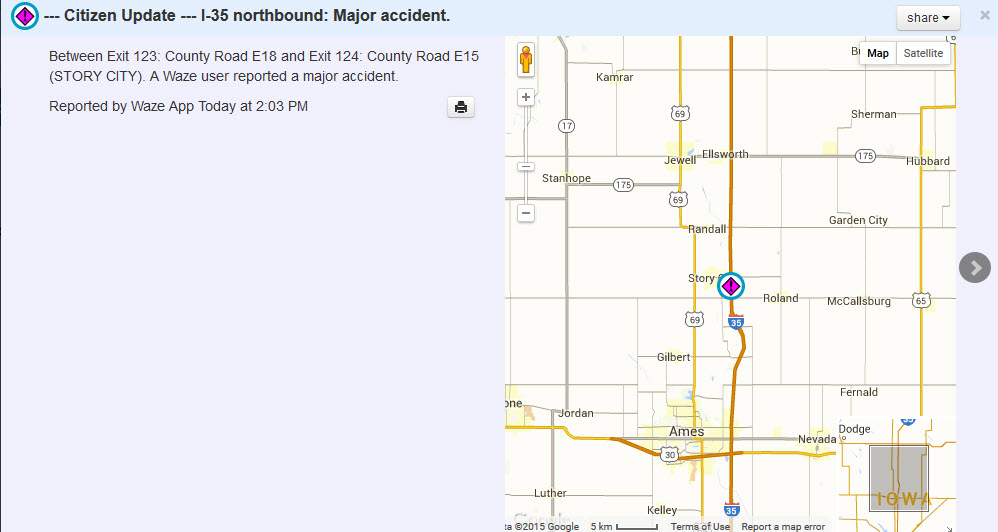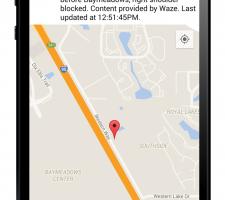
Timothy Compston finds out if exchanging traffic and road condition data with private app developers makes sense for both drivers and road authorities.
Much has been said about the potential benefits for authorities in sharing data with traffic and navigation app developers, and receiving ‘crowdsourced’ information in return – so how is it working in practice?
An app developer very much in the fast lane for two-way traffic-related data sharing is
For the uninitiated, Waze is basically a ‘crowdsourced’ navigation app which collects and shares real-time information from users. So-called ‘Wazers’ enable Waze, when the app is on, to collect data on their vehicle’s location and speed. The app also encourages ‘Wazers’ to send in reports – which are rated by other users - on the events and conditions they encounter on the roadway.
Connected data
According to Paige Fitzgerald who oversees the Connected Citizens Program at Waze, there are two main goals informing this information exchange process: “The first is to make the Waze map as good as it can be for our local users. Our government partners have really valuable data sets with the best advance notice of road closures.” Fitzgerald adds that a second ‘goal’ occurred more organically when it was realised that - going in the other direction - Waze’s data was very valuable to these same partners: “Most particularly the incident data.”
Fitzgerald says Waze’s partnership efforts really kicked into gear in 2013 when it was approached by the authorities in Rio de Janeiro, Brazil, prior to the Pope’s visit: “They [Rio] were worried about congestion preceding, and during, his visit, so they wanted to have the best data on where obstructions were occurring.”
On the question of privacy, Fitzgerald is quick to reassure ‘Wazers’ that the user reported incident information Waze’s partners ingest is already publically available: “We [Waze] don’t share any personal user details like user names, comments, or photos - just the reported incidents. Whether it is a five-car pile-up or a pothole, all that information can then go to the government body to address in real time.”
As well as immediate issues, Fitzgerald suggests Waze’s data is invaluable for longer term planning, helping DOTs and municipalities identify hotspots for every type of incident from vehicle collisions to cars parked on the shoulder.
Storming ahead
In May 2014 Florida Department of Transportation (FDOT) gave the ‘green light’ to a data sharing partnership with Waze – the first American DOT to do so. Russell Allen, ITS program development engineer at FDOT, believes that as a major tourist state, it is important to deliver the best possible traveller information to motorists: “Having extra eyes on Florida’s highways is helpful, especially on the highways that are not instrumented with cameras and detectors. Anything that we can do to utilise the data we have, and private sector data, to better prepare the travelling public is worth looking into.”
Speaking to ITS International as a storm system loomed, Allen said the Waze data could, potentially, come into its own when disruptive weather hits: “We experience things like debris in the roadway and flooding. Where there is any kind of incident or location-based threat for the motorist, then the crowdsourced people can lock that into Waze and we can relay that [information] to our system.”
As FDOT can filter the data that it takes from Waze, one capability Allen reckons could be geared up when the worst happens - which Florida’s current 511 traveller information system doesn’t do - is the ability to highlight gas stations that still hold fuel: “This could prove invaluable if an evacuation is required as a big problem, with all our highways heading north to get off the peninsula, is actually finding gas,” says Allen.
Allen says the ‘partnership’ road ran smoothly: “In order to collect the Waze data we had to develop a software interface and that was pretty painless.” He adds that other state DOTs have been in touch to learn from Florida’s experience: “Each conversation is different, but the overall conclusion is that crowdsourcing data from partners such as Waze is a source of real-time information that results in little or no cost to the transport agency.”
Citizen reports
In the Pacific Northwest, Oregon DOT recently signed up to a data exchange with Waze. Galen McGill, ITS manager at Oregon DOT, explains the rationale: “We have people scattered across the state but they are not everywhere all of the time.” He acknowledges that, unlike some states, Oregon didn’t necessarily have the resources to build up its own network of ‘citizen reporters’ and that it was probably a better approach to work with Waze.
In practice, McGill believes that Oregon may not utilise all of the Waze data on offer: “It is a different type of data than we are used to, obviously being user reported. There has had to be a little bit of filtering. We have had to say ‘which of the data is important to share [with drivers]?’ We are looking at the more major incident. Potholes may be useful to know about internally but not something we feel the need to report to folks. One thing that we won’t report by policy, is police locations,” says McGill.
Mutual benefits
Iowa DOT (IDOT) is also starting a relationship with Waze. Sinclair Stolle, IDOT’s traveller information program manager, is enthusiastic about the potential: “We are always looking at ways to broaden the reach of our information, traffic information, closures and construction to the public and the media. Having the two-way data exchange between IDOT and Waze is a mutually beneficial arrangement.”
Stolle says finalising the contract took longer than putting the data on Iowa’s website, which was partly down to ensuring that as a public agency it tied in with any ‘open records’ legal requirements: “Once we got that in place and had access to the data feed it was about three months to tweak it to what we needed.”
As with other DOTs, Stolle confirms that Iowa is filtering the data: “We want it to be the most impactful for our website and our traveller information system,” she says.
Touching on the display of each other’s data, Stolle explains that anything Waze takes from IDOT’s data feed is displayed on the app as ‘the DOT reported it’: “On the other end, events on our website, mobile app and 511 phone system say that it is a ‘citizen report’ reported by the Waze app.”
She feels that it is important that the icons on the websites and mobile app are similar to those for the DOT’s own events: “They are just a little bit different so you can still relate to them and not have to learn a new set of icons.”
Beta testing
In Brazil, Pedro Junqueira who is executive chief of the Rio Operations Centre (ROC), explains that the tie-up with Waze builds on Rio’s reputation as being ahead of the technology curve as a ‘beta-tester’ city: “The partnership was really an idea from the Mayor of Rio, Eduardo Paes. He challenged us to have Waze data as part of our tools in just a few weeks and we achieved this integration with the Operations Centre,” explains Junqueira.
“The partnership with Waze means that the ROC receives, in real time, the app’s user information throughout Rio,” says Junqueira. He adds that reports of crashes, traffic conditions and stalled vehicles reported by the Waze community also appear on a geo-referenced map in the situation room.
For Junqueira, Waze is one of ‘the greatest’ examples of a crowdsourced app: “In relation to traffic control they are miles ahead of any other tool we’ve heard about.” Asked whether other cities or DOTs should follow Rio’s example, Junqueira’s reply is brief and to the point: “Do it!”
Research study
Across in New Zealand, Sonia Pollard, the national programme development manager for the Transport Operation Centres, is a strong advocate of an ‘open approach’ to data. Although it is still early days, Collard confirms that the New Zealand Transport Agency recently commissioned a study to assess the potential for crowdsourced data: “This includes a review of partnering with private agencies to review how we increase data inputs and share our data to improve the information that we provide to transport users.”
- About the Author - Timothy Compston is a freelance journalist who specialises in traffic technology and security issues.













